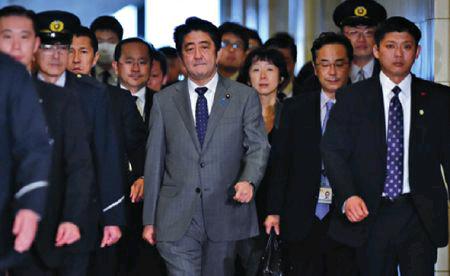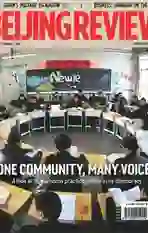Breaking Down the Military Ban
2015-03-12ByZhouYongsheng
By+Zhou+Yongsheng
Japans cabinet on February 10 adopted a foreign aid charter stating for the first time that its official development assistance (ODA) program can be used to support foreign armed forces. The newly enforced Development Cooperation Charter, previously known as the ODA Charter, said military aid is allowed to be used in non-combat operations such as disaster relief, infrastructure building and coast guard activities.
The administrations murky language may allow for flexibility in the charters use.
The new charter said, “If the military or military officers of recipient countries are involved in development cooperation for the purpose of [improving] the peoples livelihood and nonmilitary activities such as disaster relief, [Japan] will consider individual programs case by case, while taking into account the significance of extending such aid.”
This first revision of Japans ODA Charter since 2003 effectively lifted the ban on using ODA funds to assist foreign military forces, reflecting Prime Minister Shinzo Abes push to make a “proactive contribution to peace based on the principle of international cooperation.”
Adding military aid to the charter reveals a critical change to Japans ODA policy and breaks the countrys long-standing constitutional commitment to peace. The charter said ODA aid also includes activities in the fields of maritime, space, cyber security, counterterrorism, and mine clearance.
In addition, “Japan will utilize its ODA in a strategic and effective manner,” the charter said.
Furthermore, the charter for the first time has referred to “national interests” as objectives in the provision of foreign aid, according to Japans Foreign Ministry officials.
Thus far, Japans ODA primarily targets infrastructure construction and poverty reduction in recipient countries, and is disbursed in such forms as loans, grants and technical cooperation.
Accelerating military exports
Abes administration has been working to break the taboo limiting the countrys security apparatus in three steps: lifting the ban on arms exports, asserting the right of collective self-defense, and adding military aid to the ODA program. In the past year, the first two objectives have already been realized. The third step is under way.
In the past, the Japanese Government has consistently declined to use ODA for military purposes, stressing repeatedly that providing military aid does not conform to the charters principles. While initially reserved for promoting economic development, the Abe administration has fundamentally altered the tone of the program.
The move has sparked speculation over whether the same aid could be funneled for military purposes. In response to these concerns, the Japanese foreign ministry said the charter was designed to avoid aiding parties involved in international conflicts. A similar explanation was given by the Abe administration to quell concerns over the right of collective selfdefense last year.
Right-wing Japanese politicians have recently been trying to revise the restrictive pacifist constitution, but have been met with resistance both domestically and abroad. They have instead sought to relax the restrictions against using the ODA for military purposes.
Japan tried to add military aid to the ODA program as early as in April 2012, when then Japanese Prime Minister Noda yoshihiko offered patrol ships to the Philippines amid its row with China over Chinas Huangyan Island. yoshihiko proposed to provide the Philippines loans to buy the patrol ship in the form of a special use of the ODA to support the Philippines and abet the conflict. However, the plan was put on hold with the resignation of yoshihikos cabinet at the end of 2012.
Abe then upheld his predecessors proposal after winning the parliamentary election and assuming office in 2012. The Philippines lacked the funds to pay for the patrol ships, but Abe insisted on providing them free of charge. Whether in the form of a loan or a donation, the patrol ship stood as a kind of ODA-based military aid.
Besides the Philippines, the Abe administration has planned to market Japan-made patrol ships to other countries that have disputes with China in the South China Sea, such as viet Nam.
Moreover, providing the Philippines with a patrol ship will inevitably stir up tensions in the South China Sea. The risky move casts doubt on the Abe administrations promise to avoid the use of ODA aid to abet international conflicts.
thinly veiled
The revision of the ODA Charter is more than just a bid to support certain countries. Instead, it reveals Japans deeper strategic considerations.
Following several decades of economic growth, Chinas national strength has become superior to that of Japan in many aspects. Japan may be resistant to the idea of China playing a leading role in the East Asian region. With the goal of restoring the right to adopt military means to address disputes, Abe is pushing an amendment to the nations pacifist constitution.
The official relationship between China and Japan was frozen following the latters announcement of a “national purchase” of the Diaoyu Islands in September 2012. Japan, in the face of Chinas claims of sovereignty over the islands, has accelerated its military presence and sought to loosen constitutional restrictions amid the regional competition with China.
Abe spares no efforts in building a coalition to contain the growing influence of China. To some extent, the South China Sea issue will become more complicated if Japan provides military aid in the form of ODA to countries in the region that have territorial disputes with China. Last year, Japan unveiled plans to provide the Philippines and viet Nam with patrol ships in order to boost the two nations maritime forces. Japan hopes to capitalize on the geopolitical situation, but it cannot guarantee that its aid recipient countries would not use the money for combat operations.
Recently, two Japanese citizens were executed by Islamic State of Iraq and al-Sham militants in retaliation for Abes pledge of $200 million in aid to fight against terrorism and extremism during his latest visit to the Middle East. The prime minister stressed his determination to eradicate terrorism and strengthen Japans cooperation with the international community on this matter. He will also use the opportunity to promote the constitutional amendment enlarging the overseas activities of Japans SelfDefense Forces. In the aftermath of the hostage crisis, the new charter was revised to allow for the use of funds in counterterrorism operations.
In addition to counterterrorism, the charter includes a broad range of military aid without including specific limits. Japan may use this new flexibility to become gradually more entangled in international military conflicts, potentially violating Japans long-term pacifist foreign policy.
If so, Japans peaceful national policy that has lasted for nearly 70 years will face an end. Abe and his right-wing supporters are seeking the right to choose military means in resolving disputes, but have failed to give a clear answer as to the conditions and the degree with which it would use such force. Without firm boundaries, Japans military growth will inevitably raise concerns in East Asia.
